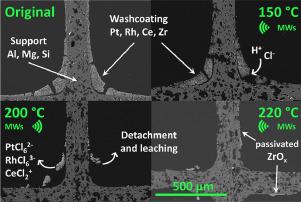Chemical Engineering and Processing: Process Intensification ( IF 3.8 ) Pub Date : 2021-03-17 , DOI: 10.1016/j.cep.2021.108378 Thomas Abo Atia , Jeroen Spooren

|
This work presents a new microwave leaching approach to solubilize platinum group metals (PGMs) and cerium from spent autocatalyst monoliths. In the proposed process, the catalyst does not require to be milled/pulverized prior to the leaching step in 6 M HCl for 3 min in the absence of an oxidation agent and internal mixing. Therefore, processing costs associated to catalyst comminution could be avoided. The highest extraction yields were achieved at 220°C at a liquid to solid ratio of 10 (Pt: 99±4%, Rh: 95±1%, Ce: 104±3%). At this temperature, the composition of the in situ generated headspace gas, including Cl2 gas that acts as oxidant, and the enhanced porosity of cordierite, improved PGM and Ce leaching. Furthermore, the blocks preserved their honeycomb structure after leaching, simplifying downstream solid-liquid separation, e.g. using gravity filtration. SEM/EDX analyses of residues’ cross-sections allowed for identifying the dissolution mechanism of the washcoating (150-220°C).
Whereas, under the same conditions ball-milled catalyst material gave significantly lower PGM leaching (Pt:47±4%, Rh: 48.6±0.3%) and a greener leaching in 1 M HCl + 3.8 M NaCl, achieved higher selectivity towards PGMs, although overall yields decreased (Pt: 68±2%, Rh: 67±5%, Ce: 39±1%).
Statement of Novelty and Significance: This work presents a novel approach to solubilize Pt, Rh and Ce from spent ceramic autocatalyst via a fast microwave leaching process (3 min) in a 6 M HCl solution at 220°C, without the need of (i) a milling pretreatment, (ii) an oxidizing/reducing agent, nor (iii) internal mixing. Therefore, the energy consumption, cost of chemicals and complexity of the process are reduced in comparison to previously described microwave assisted routes, which might benefit its upscaling. Additionally, the metal leachability was high (99±4% Pt, 95±1% Rh, 104±3% Ce), and the downstream solid-liquid separation was facilitated.
中文翻译:

从未研磨的自磨过的自催化剂整体料中快速微波浸出铂,铑和铈
这项工作提出了一种新的微波浸提方法,用于从废旧的自动催化剂整料中溶解铂族金属(PGM)和铈。在提出的方法中,不需要在没有氧化剂和内部混合的情况下在6 M HCl中进行3分钟浸提步骤之前将催化剂研磨/粉碎。因此,可以避免与催化剂粉碎相关的处理成本。液固比为10(Pt:99±4%,Rh:95±1%,Ce:104±3%)在220°C时可获得最高的提取率。在此温度下,包括Cl 2在内的原位生成的顶空气体的成分用作氧化剂的气体,以及堇青石孔隙率的提高,改善了PGM和Ce的浸出。此外,这些块在浸出之后保持其蜂窝状结构,从而简化了下游的固液分离,例如。使用重力过滤。残留物横截面的SEM / EDX分析可以确定修补基面涂层(150-220°C)的溶解机理。
而在相同条件下,球磨催化剂材料的PGM浸出率显着降低(Pt:47±4%,Rh:48.6±0.3%),在1 M HCl + 3.8 M NaCl中的浸出较绿,实现了对PGM的更高选择性,尽管总产量下降(Pt:68±2%,Rh:67±5%,Ce:39±1%)。
新颖性和意义声明:这项工作提出了一种新颖的方法,该方法可通过在220°C的6 M HCl溶液中通过快速微波浸出过程(3分钟)从快速使用的陶瓷自催化剂中溶解Pt,Rh和Ce,而无需(i )研磨预处理,(ii)氧化剂/还原剂或(iii)内部混合。因此,与先前描述的微波辅助路线相比,降低了能量消耗,化学药品的成本和工艺的复杂性,这可能有益于其扩大规模。另外,金属的浸出性高(Pt为99±4%,Rh为95±1%,Ce为104±3%),并且促进了下游的固液分离。










































 京公网安备 11010802027423号
京公网安备 11010802027423号